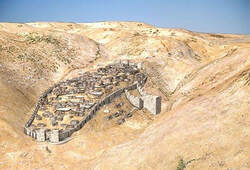On the Right is an impression of development of a settlement around the spring with early walls built to guard the settlement and the vital water supply.
The earliest record of settlement at Gihon is that of Salem where Melchizedek dwelt. Salem later became Jebus, whose occupants, the Jebus-ites (meaning ‘Downtreaders’) held it until David captured it and renamed it the City of David.
The ancient site with its amazing spring called ‘Gushing Forth’ (Gihon) had also become known as HaMakom, The Place, because it was chosen by God as central to His plans for the people He would call His own.
The Place features prominently in the Patriarchal stories of Abraham and Melchizedek, Isaac and Jacob. It was Jacob, who after his extraordinary dream/vision of angelic beings on a stairway between earth and heaven, called HaMakom ‘Beit-El’ or Bethel—House of God!
This therefore is the true Bethel. Yes, this is where he was, as the repeated use (in fact deliberate over-use) of the term HaMakom in Genesis 28:10-22 appears to be for a specific purpose. The same applies to Abraham and Isaac’s visit there in Genesis 22.
It becomes clear in the Hebrew record that it was chosen by God.
David knew this fact when he took it—and that is exactly why he pitched a tent there, right at Gihon for the Ark of the covenant and the sacred objects.
David’s son Solomon also knew this when he built the House of God (The Bethel) there, in Zion, above the Spring which provided the water for both the City of David and for the temple which was built there in Zion just above and to the west of Gihon.
For an historic narrative and perspective on this strategic site read 'THE PLACE HAMAKOM; Where Jerusalem's temples stood' (or look elsewhere on this site)


 RSS Feed
RSS Feed
